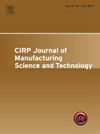The process, microstructure, and mechanical properties of hybrid manufacturing for steel injection mold components
IF 4.6
2区 工程技术
Q2 ENGINEERING, MANUFACTURING
CIRP Journal of Manufacturing Science and Technology
Pub Date : 2025-01-23
DOI:10.1016/j.cirpj.2025.01.004
引用次数: 0
Abstract
The traditional injection molding industry primarily utilizes subtractive manufacturing processes to ensure the quality of molds, which often requires high expenses. With the rapid development of additive manufacturing, the integration of additive and subtractive processes, known as hybrid manufacturing, has emerged as a new trend. This new approach necessitates comprehensive quality characterization of the produced components. This paper investigates the feasibility of hybrid manufacturing for core mold components subjected to cyclic loading conditions, utilizing laser cladding and machining. The study evaluates multiple indicators through a blend of experimental and simulation methods to assess and validate the effectiveness and practicality of the manufacturing process. In summary, the findings indicate that laser cladding technology provides high-quality, dense cladding layers with an average porosity below 0.1 %, demonstrating strong potential for industrial applications. Electron Back Scatter Diffraction (EBSD) analysis shows that the cladding layer has a larger grain size than the substrate material, consistent with microhardness tests that reveal lower hardness values in the cladding layer (mostly below 500 HV) compared to the substrate area (exceeding 500 HV) due to the process's high temperatures. Fatigue tests revealed that fit type has a significant impact on fatigue performance. Although the simulated fatigue life curve predicted a shorter life than observed experimentally, it followed a similar trend.
求助全文
约1分钟内获得全文
求助全文
来源期刊

CIRP Journal of Manufacturing Science and Technology
Engineering-Industrial and Manufacturing Engineering
CiteScore
9.10
自引率
6.20%
发文量
166
审稿时长
63 days
期刊介绍:
The CIRP Journal of Manufacturing Science and Technology (CIRP-JMST) publishes fundamental papers on manufacturing processes, production equipment and automation, product design, manufacturing systems and production organisations up to the level of the production networks, including all the related technical, human and economic factors. Preference is given to contributions describing research results whose feasibility has been demonstrated either in a laboratory or in the industrial praxis. Case studies and review papers on specific issues in manufacturing science and technology are equally encouraged.
 求助内容:
求助内容: 应助结果提醒方式:
应助结果提醒方式:


